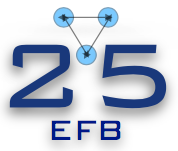Speaker
Description
We present the study of the inclusive photo-disintegration reaction $\gamma + {}^{9}\mathrm{Be} \to \alpha + \alpha + n$ at low-energy regime, including calculations of the $\alpha\alpha n$ three-body binding energy of $^9\textrm{Be}$ and the reaction cross section. The inverse process of the ${}^{9}\mathrm{Be}$ photo-disintegration, including both sequential and direct reactions combining two $\alpha$ and a neutron into $^9\textrm{Be}$, represents an alternative path to the ${}^{12}\mathrm{C}$ formation in a neutron-rich environment, therefore it is a reaction of astrophysical interest.
The shallow binding of ${}^{9}\mathrm{Be}$ below the $\alpha\alpha n$ three-body threshold and the deep binding of $\alpha$ indicates a clear separation of energy scales. For this reason, it can be studied as a three-body effective clustering system where neutrons and $\alpha$-particles interact with each other through effective potentials. In the literature one finds calculations where $\alpha$-$\alpha$ and $\alpha$-$n$ potentials of phenomenological character have been used. Here we present an attempt to use potentials derived from Halo Effective Field Theory (EFT) [1]. Given these effective potentials as an input, we solve the bound-state problem using the Non-Symmetrized Hyperspherical Harmonics (NSHH) method [2]. Then, via the Lorentz Integral Transform (LIT) method [3], we calculate the cross section of the ${}^{9}\mathrm{Be}$ photo-disintegration reaction in the low-energy regime. The key quantity to be calculated is the nuclear current matrix element. At low energy Siegert theorem ensures that the use of the dipole operator allows to take into account both the effect of the one-body convection current as well as that of two-body currents (or even of three-body ones in case of the inclusion of both two- and three-body forces). As a consequence, two types of calculations can be made: the calculation of the nuclear convection current as the nuclear current operator [4] and the calculation of the dipole operator matrix elements. This allows to quantify the contribution of higher-body currents, which are automatically included in the latter calculation. We will discuss the results focussing in particular on the interplay between these two contributions, driven by the EFT parameters, and in connection with the experimental results.
References
[1] H. W. Hammer, C. Ji, and D. R. Phillips, J. Phys. G: Nucl. Part. Phys. 44, 103002 (2017).
[2] S. Deflorian, N. Barnea, W. Leidemann, and G. Orlandini, Few-Body Syst. 54, 1879 (2013).
[3] V. D. Efros, et al., J. Phys. G: Nucl. Part. Phys. 34, R459 (2007).
[4] E. Filandri, Doctoral Thesis, University of Trento (2022).

